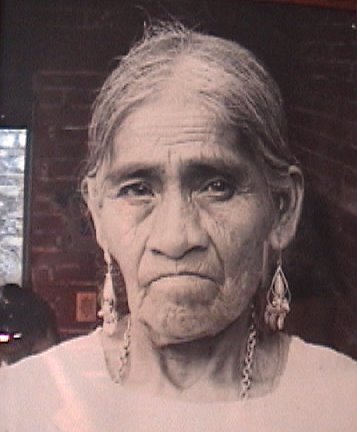A Nuanced Reflection Of Maria Sabína By Ifetayo Harvey
Portrait of María Sabina
María Sabina was a Mazatec curandera (July 22, 1894-November 23, 1985) known for being the first to welcome foreigners into veladas, the sacred Mazatec ceremony involving magic mushrooms, or psilocybin. Because of María’s openness, she is credited as being responsible for the popularization of magic mushrooms. María was married off to an older man, Serapio Martinez at the age of 14 when he was 20 years old. After six years, Martinez died and it would be 12 years before Sabina married again. At 32, Sabina married Martiel Carrera and in her second marriage, Sabina was subjected to his frequent drunkenness and physical abuse. They lived together for 13 years until his death at the hands of another woman with whom he was having an affair with. After, María made her way to becoming a healer.
In many cultures under colonized rule, syncretism is the practice of an attempted amalgamation of different religions. In Sabina’s case, she took the religion of the Spaniards, Catholicism, and used that to mask their Indigenous practices. María was known to personify the mushrooms, calling them niñitos (“little children”). Sabina drew on an ancient tradition of honoring the mushrooms as evidenced by Mesoamerican mushroom stones. Many Indigenous practices were forced to go in hiding because colonizers constantly disrespected them. Even before Wasson arrived, Spanish conquistadores wrote in their journals that the mushrooms also known as teonanácatl were diabolical.
In 1955, R. Gordon Wasson, an American mycologist and banker, made his way to María in Huautla de Jimenez, Oaxaca where she performed a velada. Later, in 1957, Wasson took his experience and shared it in a few publications, including Life that led droves of foreigners down to María’s village. Unbeknownst to Sabina, Wasson had revealed her identity and location in these publications. María became known to many around the world as a healer and is held in similar regard as psychedelic giants like Terence McKenna and Albert Hofmann, who synthesized LSD; yet unlike these men, María died poor and ostracized in her community because of the war on drugs and its intersectional impacts on an Indigenous woman from a rural community. María’s life is important in understanding how the war on drugs and commodification of psychedelics have impacted Indigenous communities’ healing practices. In the end, Wasson’s breach of trust caused an influx of outsiders which resulted in María facing police surveillance and someone burning down her house.
Years after María’s death, psychedelic enthusiasts like Soma Phoenix attend María Sabina Day (July 22nd) festivities in Huautla that are filled with art on display, books, and the community coming together. Soma is a psychedelic enthusiast and researcher who sought to pay homage to María Sabina because of their passion for mushrooms. Yet, after observing the festivities, Soma felt as though “there needs to be more effort put towards preserving her memory.” One cannot talk about María Sabina’s public memory without talking about the impact of colonization and patriarchy. Fabiola Santiago decided to seek out a velada during one of her trips visiting family. According to Fabiola, who was born in Oaxaca, mushroom ceremonies are known, but the war on drugs has tainted the locals' understanding of them. Now mushrooms and cannabis are seen as “dangerous drugs”. Many of the youth are afraid of engaging with their ancestral medicine. Since Wasson’s betrayal of Sabina’s name and location, there has been no shortage of tourists and now even settlers creating their own communities in Oaxaca. Fabiola added that many of these foreigners are known for improperly picking mushrooms, causing scarcity for the locals. Soma and Fabiola took part in veladas led by locals which opened their eyes to the urgency in preserving and uplifting María Sabina’s legacy.
As a Mazatec woman, María knew the importance of maintaining a relationship with the land and her importance as a steward of medicine. Today, along with the María Sabina Day festivities and art, there are a number of materials from Sabina’s life: news articles, photographs, textiles, musical recordings, videos, and interviews are all stored in Huautla. After visiting the archives, Soma Phoenix realized that “it would take years to go through all of the materials.” So why hasn’t there been much investment from psychedelic organizations in preserving Sabina’s memory? Instead of the watered down, “magical Indigenous person” trope that Sabina is often boxed into, there needs to be a concerted effort to preserve her memory. In 2018, Cosmovisiones Ancestrales and POC Psychedelic Collective collaborated on a fundraiser for preserving her archive, over $10,000 was raised, but there needs to be more contributions from the most established psychedelic organizations. If not, María’s story serves as a cautionary tale: through pain, there can be self healing, but be wary of those with power and resources who care more about the benefits of the medicine, but lack respect for the practitioners and their culture. Here are three things that you can do to honor María Sabina’s legacy:
Research her life and her culture. Don’t rely on the dominant narrative.
Support Indigenous communities--whether it be through financial means or others, listen to the needs of the community that you’re working with and figure out what you can offer.
Uplift and give resources to indigenous voices in the psychedelic world.


